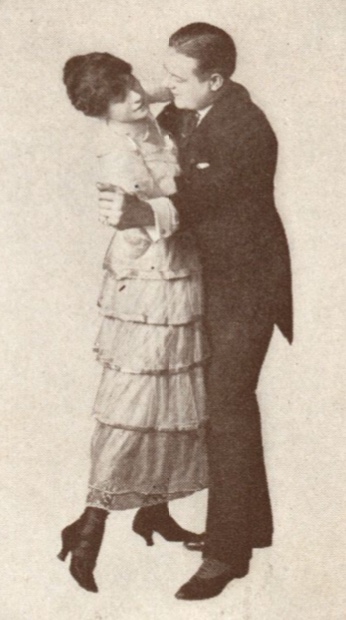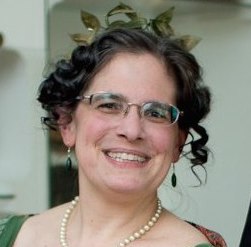Maxixe in the foxtrot? They mixed bits and pieces of every other dance of the ragtime era together, so why not jazz up your foxtrot with a little body sway?

At least two different sources suggest using maxixe-styled two-step in the foxtrot: Joan Sawyer’s How to Dance the Fox Trot (Columbia Graphaphone Company, New York,1914) and Description of Modern Dances, as Standardized by the New York Society Teachers of Dancing and approved by the Congress of Dancing Societies of America at meeting held December 27th, 1914, in New York City, N. Y. (American National Association Masters of Dancing, Pittsburgh, 1915).
I’ll start with Sawyer, since her booklet (dated November 23, 1914), is chronologically earlier. Her foxtrot figures all consist of a pattern of a unique step or sequence followed by eight trotting steps. Her third figure, the Maxixe-Glide and “Trot”, starts with four measures of “Maxixe two-step” done moving along the line of dance (gentleman forward, lady backward) without turning. The two-steps begin with the gentleman’s left foot, lady’s right; feet then alternate as usual
Sawyer’s illustration of the “very first motion of the Maxixe-glide”, shown at left (click to enlarge), is missing the characteristic heel lead of the maxixe, but it does hint at the body sway in the bend of the dancers toward their lead feet. I would expect them to bring their joined hands up during the remainder of the first two-step and ended it with their bodies bent the opposite way, then swaying the other way as they two-step “over elbows” toward their second foot, ending in about the position shown in the illustration.
Following four two-steps forward (counted 1&2 each) for four bars total, the dancers then do eight trotting steps (counted 1&2&3&4&) for two bars total. The entire six bars is then repeated, making a twelve-bar sequence. This is really a very standard mix of two-step and trotting steps, very much in the pattern of other two-step combinations in the foxtrot. Its only point of distinction is the maxixe styling.
Similarly, the figure standardized by the New York Society Teachers of Dancing and eventually published in the proceedings of their convention is a very ordinary combination, though at least it includes turning. The two-steps and the running steps (trots) alternate:
1b one turning”Maxixe two-step” (half-turn) (QQS)
1b four running steps (QQQQ)
1b one turning “Maxixe two-step” (half-turn) (QQS)
1b four running steps (QQQQ)
4b repeat all of the above
This is a nice, straightforward, musically square eight-bar sequence. The gentleman starts on the left foot, the lady on the right, they make a half turn so that the first four running steps have the gentleman going backwards, then finish the turn and run again with the lady going backwards. The only thing indicating the maxixe styling is the word “Maxixe” attached to the two-step.
Of the two, I actually prefer the dancing-masters version. It’s better matched to musical patterns, it has shorter pieces with more frequent alternation — I am not a fan of long sequences of backward trotting steps for ladies — and it turns. I would also consider it valid to break up the sequences and just mix maxixe-styled two-step into walking and trotting in the same way one can mix a plain two-step.


Leave a Reply